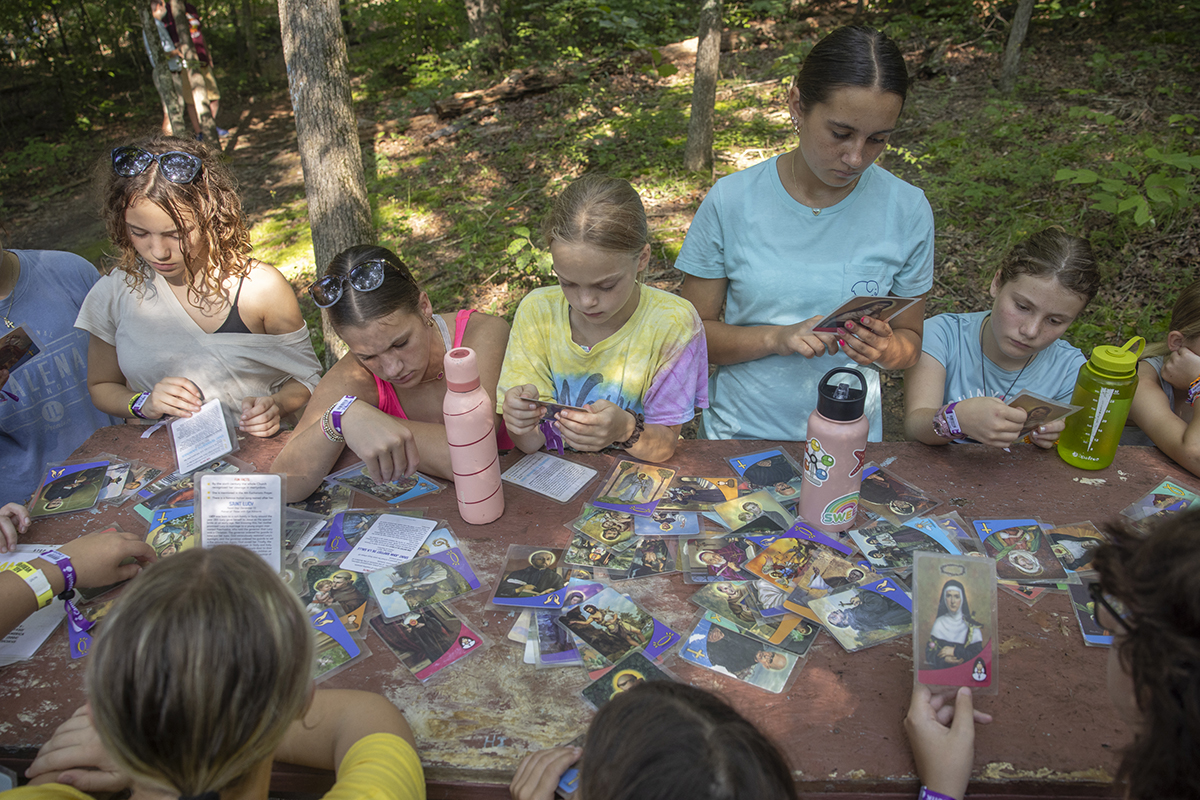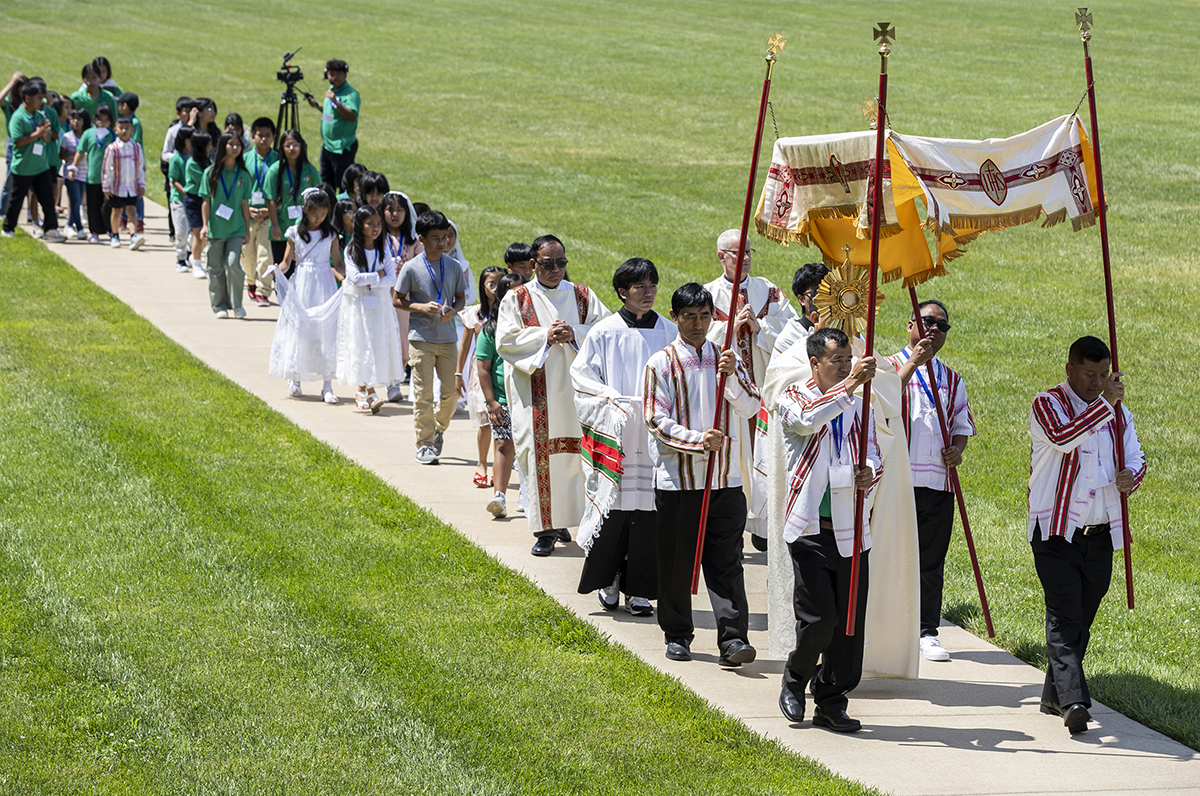Truth and Freedom
“Forgive Us Our Trespasses” prayer service and Maafa commemoration draws attention to truth of slave trade in the Archdiocese of St. Louis and the stories of those who were enslaved
Prayer, songs and the stories of people who were enslaved in St. Louis were at the forefront of a prayer service and Maafa procession held June 18 at the Basilica of St. Louis, King of France (Old Cathedral).
The archdiocese and its Office of Racial Harmony organized “Forgive Us Our Trespasses,” which included a prayer service featuring Archbishop Mitchell T. Rozanski and other area faith leaders at the Old Cathedral, followed by a Maafa procession to the south pond on the grounds of the St. Louis Gateway Arch.
Maafa, a Swahili word for “great disaster,” is a traditional procession to memorialize the lives of those lost during the Middle Passage, or transatlantic slave trade.
In reflecting on the inaugural event, Archbishop Rozanski said two words kept coming to his mind: truth and freedom.
“When we embrace the truth … can every human being created truly live in freedom,” he said. Reflecting on the past, as painful as it may be, is an important part in moving forward to change the future, understanding that every human being is created in the image of God and has a God-given dignity.
Each one of us “is given human dignity to live in freedom, to live in truth, to be able to bring that image of God into the world in such a way that our whole world is transformed,” he said.
Several speakers recalled stories of enslaved people, as well as historical sites in St. Louis related to the slave trade.
The gathering also included a formal acknowledgement of the Archdiocese of St. Louis’ past involvement with the institution of slavery. The archdiocese has been researching that history as part of a project called “Forgive Us Our Trespasses.”
Bishop William DuBourg (who at the time was Bishop of Louisiana and the Two Floridas, with his episcopal seat in St. Louis), Bishop Joseph Rosati and Archbishop Peter Kenrick enslaved people, as did an unknown number of clergy. The Archives Office has discovered the names of at least 85 enslaved people, with more expected.
Danielle Harrison, director of mission and charism at Cor Jesu Academy who emceed the event, told participants that the stories shared that day would be difficult to hear, but challenged everyone to keep their hearts open to where God might be calling them.
“We’re here to remember. We’re here to honor the sacrifice. But we are also here to understand where we fit in the story,” she said. “Because that’s what keeps it alive. We are here to do hard work. But we even in our fear we are brave, to look at what was unlookable. To understand was not understandable. To grasp where is God calling us.”
Among the stories shared was that of Peter, a young enslaved person who was sold by Bishop Joseph Rosati. In a financial ledger from 1830-39, Bishop Rosati recorded the sale of “my negro boy called Peter about nine or ten years old” to Vincentian Father John Bouiller for the sum of $150.
Jesuit Father Jeffrey Harrison with the Jesuits’ Slavery, History, Memory and Reconciliation Project, spoke about the Queen, Brown and Hawkins families, all of whom were enslaved by the Jesuits when the religious order was becoming established in St. Louis. Among them was Peter Queen-Hawkins, the son of two slaves, Isaac Hawkins and Susan Queen, who came to Missouri with the Jesuits from White Marsh plantation in Maryland. He remained with the Jesuits until he died around 1907, spending his entire life in service to the Jesuits.
Other speakers included Church historian Msgr. Michael Witt; Father Art Cavitt, executive director of the St. Charles Lwanga Center and pastor of St. Nicholas Parish in St. Louis; Rev. Anthony Riley, senior pastor of Central Baptist Church; Rev. Anthony Witherspoon of Washington Metropolitan AME; Nikki Williams-Sebastian, graduate of Rosati-Kain High School and now an Atlanta-based genealogist; and Rev. Brandon Wilkes, co-pastor of Peoples Church STL and executive director of the St. Louis Reconciliation Network.
Father Peter Faimega, pastor of St. Norbert Parish in Florissant who gave a Scripture reading at the prayer service, said he sees his role as simply being part of the story, by giving honor to his ancestors and remembering those who were enslaved in St. Louis.
The native of Nigeria, who was ordained in 2017 for the Archdiocese of St. Louis and is starting a ministry for African Catholics in St. Louis, said, “we are part of building this nation. So I want to continue with the work, to do my little part in helping to promote the work here.”
Lauren Drummond Littrell, who attended the prayer service and procession with several members of her family, said it was God who called her to start Love One Another Ministries following the death of Michael Brown in Ferguson in 2014 and some negative experiences her son had at an area private Catholic high school.
The ministry, she said, focuses on promoting the Gospel message of Jesus Christ to love one another, and works with schools, churches and other organizations to have an active role in racial healing, restoration and reconciliation, through a program called The Unity Lab.
“The Lord put it on my heart to do something to promote healing, restoration and reconciliation in the Body of Christ,” she said. “We have a high incidence of suicide among young African Americans. They’re hurting. They’re feeling not seen and heard because of racism and so many other things. We need to do something to make sure that they’re hopeful about the future.”
Former slave trade locations in St. Louis
• Original slave pen: Located at Fourth and Locust streets; now the site of the Federal Reserve Bank of St. Louis. Before the Civil War, Bernard Lynch owned the largest slave market in St. Louis. His operation included an office at 104 Locust Street and a holding pen for enslaved people at 5th and Myrtle, the present-day Broadway and Clark
• Lynch’s slave-holding pen: In 1859, Lynch opened a slave pen at 5th and Myrtle. It eventually became a storage building for the Meyer Brothers Drug Company and was demolished in 1963 to build Busch Stadium.
• Lynch’s office: Located at 104 Locust Street; now a part of the grounds of the Gateway Arch
• Old Courthouse: Slave auctions were held on the steps of the Old Courthouse
• Planter’s House Hotel: Now the site of the Hyatt Regency Hotel Downtown, this was a hotel where smaller travelling slave trade dealers operated
• Corbin Thompson’s Slave Market: Now the site of Kiener Plaza, Corbin Thompson ran the second-largest slave market in St. Louis
>> Freedom Suits Memorial

A sculpture honoring enslaved Missourians who fought for their freedom through the courts prior to the Civil War was dedicated June 20 in Downtown St. Louis.
The Freedom Suits Memorial was designed by Preston Jackson, professor emeritus at the School of the Art Institute in Chicago. Located outside the Civil Courts building, the 14-foot sculpture depicts various moments from the lawsuits and the times. At the base are the names of more than 300 people who asked the court for their freedom more than 150 years ago.
Before the U.S. Supreme Court’s decision in Dred Scott v. Sandford, Missouri’s legal system operated under a “once free, always free” policy. The courts held that an enslaved person who had been moved to a free state or territory for any length of time, then returned to a slave state or territory could sue for his or her freedom.
Judge David Mason of the 22nd Circuit Court, helped form and lead the Freedom Suits Memorial Steering Committee after the legal files of enslaved people who petitioned the court were found by courthouse employees more than a decade ago.
“It was like discovering a new vein of gold” said Mason, a member of St. Alphonsus Liguori “Rock” Church Parish. The memorial, he said, “honors their courage and bravery, the judges who upheld the rule of the law, and the lawyers and the juries who decided in favor of the enslaved person.”
Any enslaved person who sued for their freedom faced a great risk. If they lost, they were likely to suffer painful retribution or be sold “down the river” to a more brutal owner in the south.
St. Louis was an epicenter for freedom suits for nearly 60 years, from the time of the Louisiana Purchase until the Emancipation Proclamation, said Mason. The Supreme Court’s decision in the Dred Scott case essentially undid the results of the freedom suits that had been filed.
But that case changed everything — and was a step on the path leading to the start of the Civil War.
Prayer, songs and the stories of people who were enslaved in St. Louis were at the forefront of a prayer service and Maafa procession held June 18 at the Basilica … Truth and Freedom
Subscribe to Read All St. Louis Review Stories
All readers receive 5 stories to read free per month. After that, readers will need to be logged in.
If you are currently receive the St. Louis Review at your home or office, please send your name and address (and subscriber id if you know it) to subscriptions@stlouisreview.com to get your login information.
If you are not currently a subscriber to the St. Louis Review, please contact subscriptions@stlouisreview.com for information on how to subscribe.





